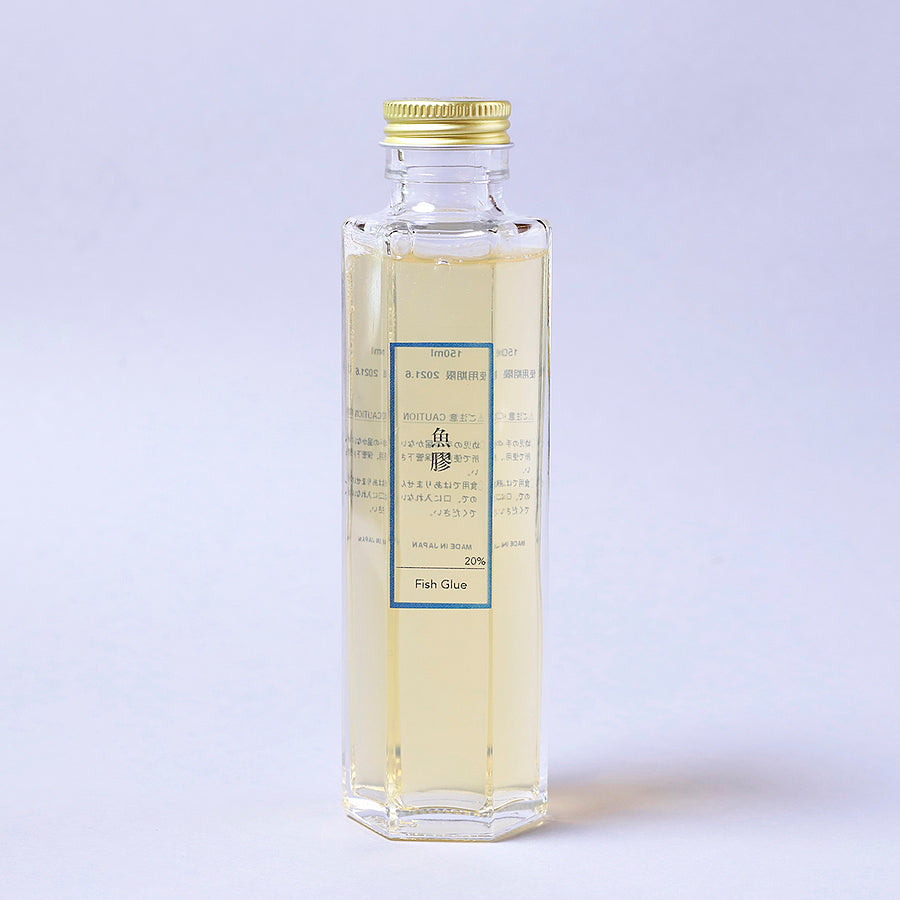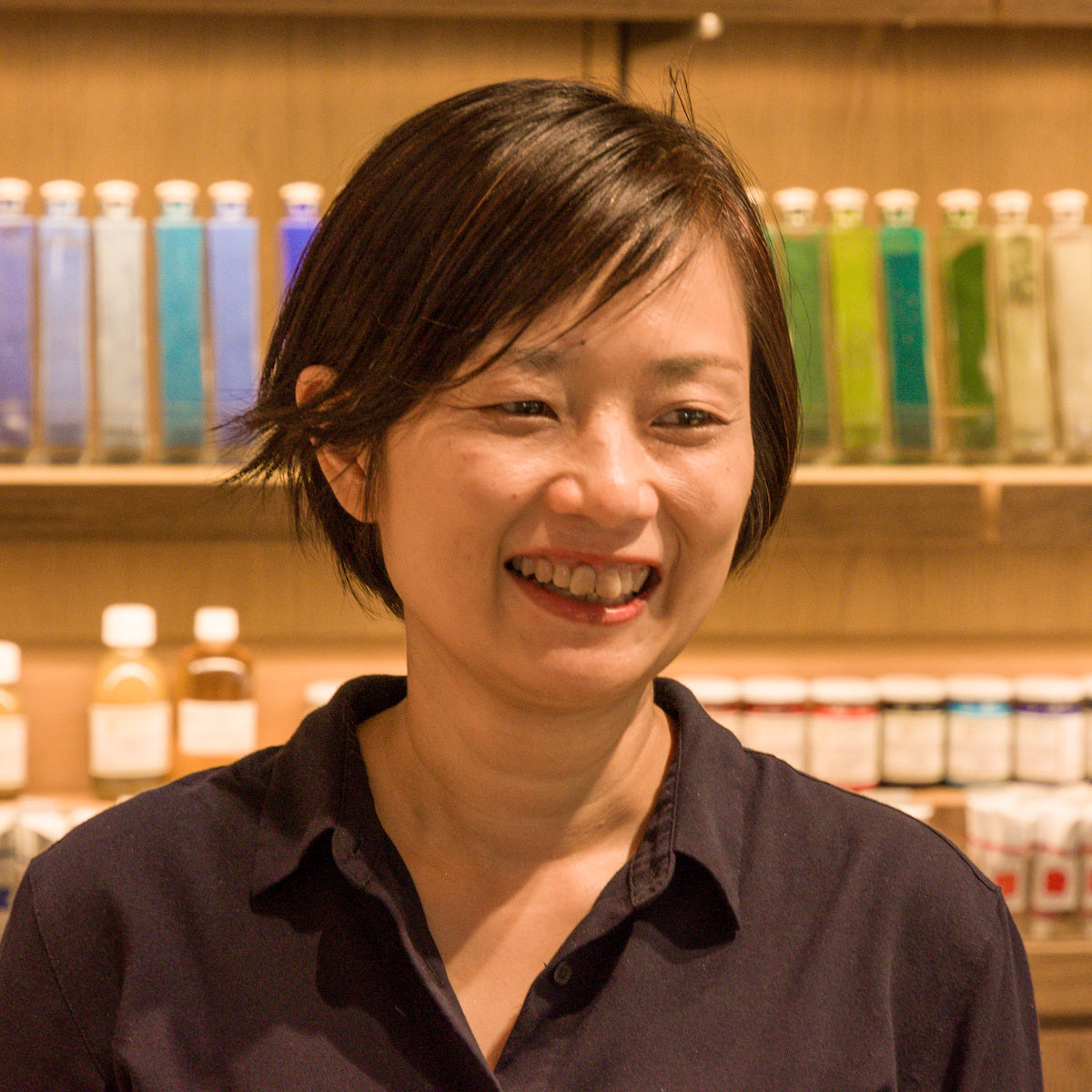There are many different tools for applying metal leaf,andadhesive is the first essential material.
However, there are several types of adhesive, and some people may be wondering which one to choose.
This time, I would like to introduce thegilding adhesives thatare recommended in our lab.
This is PIGMENT's original Fish Glue.
【How to Use】
For sizing (prevent from bleeding): 4~5% solution of fish glue
For metal leafapplication:1.5~3% solution of fish glue and 1% solution of alginate.Medium for Kindei (pure gold powder) and pearlescent pigments: 1.5~3% solution of fish glue
【Physical Properties】(as of August 9, 2021)
Viscosity: 28.2 mPa・s
Jelly Strength: JS 585g
pH: 5.8
This glue is used in the application of dosa, sizing to prevent bleeding/blurring of Japanese paper and silk.
Because of its high jelly strength, it provides a water-repellent effect without adding alum. Also, the color is nearly clear and has almost no impact on the base materials.
Jelly strength is a number that indicates the strength of the glue; the higher the number, the stronger the jelly.
For example, the jelly strength of this fish glue is 585g; it is relatively highcompared to other glues derived from cattle, deer, or fish of whichjelly strength isgenerally 100-300g.
Due to its high jelly strength, it may cause the surface to crack. Therefore, it is not suitable as a painting medium other than mixing with Kindei (pure gold powder) or pearlescent pigments.
*Sorry, this item is no longer available.
Fish glue, mentioned above and this solution are both originally the same thing.
It is a 20% solution of the granulated fish glue, and you can use it for the same purpose as the previous one.
Since this fish glue solution contains preservatives, it will last longer.Please store it in a refrigerator after opening the bottle. It becomes jelly-like when cold, so it needs to bebrought back to room temperature or dissolved in a double boiler before use.
This 20% solution can be ready to be usedby simply diluting it with water to the concentration depending on the purpose of use.
It is also great for first-time users and for use in small amounts.
And another use is asglue for metal leaf application.
When applying metal leaf l using the fish glue, the glue solution alone will dry out, so an alginate solution is added to slow the drying process.
Sodium Alginate is a thickening agent extracted from a type of seaweed called Funori.
Dilute the fish glue solution to 1.5–3% and add the alginate solution.The good ratio is about 1 part sodium alginate solution to 2 or 3 parts fish glue solution. You can adjust its thickness as you like from there.
Moreover, using the mixture of fish glue and alginate as an adhesive is ideal for the basic flat metal sheet application such as Hiraoshi and also for applying finely powdered metal leaf called Sunago.

In addition, PIGMENT TOKYO has another type of fish glue as well.
【How to Use】
For painting (as a medium)
For metal leaf application
【Physical Properties】 (as of August 9, 2021)
Viscosity: 4.2 mPa・s
Jelly Strength: JS 310g
pH: 4.4
※Physical properties may vary by lots. Please check the details on the product page when purchasing from our online store.
The jelly strength of this fish glue is not as high as the ones introduced above, so it can be used as a medium for painting. It has less affect to the white or light color pigments than brownish animalglue, so you may want to choose the animal glue depending on your purposes.
Our lab recommends adding a preservative when making your own animal glue solution.
If you add a preservative to it, you can keep it in a refrigerator for about a year. However, without it, it will turn bad quickly so should be used within 2-3 days.
Furthermore, if the preservative is added when the glue is hot, it will not be effective. Let it cool down before adding it.
This product can be used for lasting animal glue other than fish glue. It is an amazing item for those who want to try various painting mediums.
Other than animal glue, a very popular Italian adhesive for metal leaf, Gilding Size/Missione all'Acqua is available.
While the fish glue is a traditional adhesive, this was created after the modern era.
Since it is made of acrylic resin, it is very viscous and remains stickiness for a long time even after the surface dries.
For this reason, it is suitable for those who are applying metal leaf for the first time and for applying small shapes of metal leaf, but it is not recommended for the Sunago Technique.
It also has the advantage of being able to be stored at room temperature, so it can be used in any environment.
Then,what will happen when applying a small piece or detailed patterns of metal leafwith the Missione all'Acqua?

The image above shows a line drawing of metal leaf.
The letters were drawn withMissione all'Acquaon a brush and applied metal leaf on top of it. If you remove the excess metal leafwith a flat brush after the adhesive is dried, the pattern will appear.
Even after a little while has passed after applying the Missione all'Acqua, it remains viscous enough that you can feel the stickiness on your fingers when you touch it;it allows you to work slowly.
As mentioned above, it is very sticky, so using nylon brushes are easier to clean than animal hair brushes.
Although, if you apply too much Missione all'Acqua or rub the metal leaf too hard when applying it to a surface, the adhesive may spread out from the shapes and the edge of the shapes will not be clear.
Here is an image painted with the Missione all'Acqua using a hard-bristled brush.
Sumi ink, Daiwagaboku Akanegumo is painted as a base coat.

The image below is after applying the metal leaf and removing it with a slightly harder brush.
If you compare the two images, you can see that the metal leaf has been also sticked on where there were no brush marks.
I applied the metal leaf more than five minutes after applying the Missione all'Acqua. Since I pressed and rubbed it a little harder, the metal leaf is fixed quite well.
Like I did, even if the form will appear different from what you imagine, it may fun to incorporate it as your own expression.

The process will vary depending onsubstrates and designs, but I hope you will take advantage of the characteristics of each adhesive, and will.
enjoy the world of metal leaf from deciding which adhesive to use for your art.












